| [1] Dirk Jan F Moojen, Jasper H Zwiers, Vanessa AB Scholte,et al. Similar success rates for single and multiple debridement surgery for acute hip arthroplasty infection.Acta Orthop.2014;85(4): 383-388.[2] Ong T, Anand V, Tan W, et al.Patient characteristics and outcomes of a hip fracture and concomitant fracture compared with hip fracture alone: results from a United Kingdom teaching hospital. Arch Orthop Trauma Surg.2016;136(4):463-467.[3] Milosev I, Trebse R, Kovac S, et al. Survivorship and retrieval analysis of Sikomet metal-on-metal total hip replacements at a mean of seven years.J Bone Joint Surg Am.2006;88(6): 1173-1182.[4] 吕亮,王福生,卢敏,等. 人工髋关节置换术后感染的危险因素分析及预防[J].中华医院感染学杂志,2013,23(6):1334-1336.[5] Byren I, Bejon P, Atkins BL, et al. One hundred and twelve infected arthroplasties treated with 'DAIR' (debridement, antibiotics and implant retention): antibiotic duration and outcome. J Antimicrob Chemother.2009;63(6):1264-1271.[6] Estes CS, Beauchamp CP, Clarke HD, et al. A two-stage retention débridement protocol for acute periprosthetic joint infections.Clin Orthop Relat Res. 2010;468(8): 2029-2038.[7] Winkler H, Stoiber A, Kaudela K, et al. One stage uncemented revision of infected total hip replacement using cancellous allograft bone impregnated with antibiotics. J Bone Joint Surg Br.2008;90(12):1580-1584.[8] Rudelli S,Uip D,Honda E,et al.One-stage revision of infected total hip arthroplasty with bone graft. J Arthroplasty.2008;23(8):1165-1177.[9] Matthias Wolf, Heimo Clar, Jörg Friesenbichler,et al. Prosthetic joint infection following total hip replacement: results of one-stage versus two-stage exchange. Int Orthop.2014;38(7):1363-1368.[10] Ke Liu,Jia Zheng,Yi Jin,et al.Application of temporarily functional antibiotic-containing bone cement prosthesis in revision hip arthroplasty.Eur J Orthop Surg Traumatol.2014;24(1): 51-55.[11] Chen SY, Hu CC, Chen CC,et al. Two-stage revision arthroplasty for periprosthetic hip infection: mean follow-up of ten years.Biomed Res Int.2015;2015:345475.[12] 郭国栋,樊根涛,郭亭,等.人工髋关节置换后感染二期翻修中的彻底清创[J].中国组织工程研究,2015,19(48):7741-7746.[13] 张理昂,周一新,李玉军,等.髋关节置换术后假体周围感染的治疗[J].中华骨科杂志,2009,29(10):924-928.[14] Kim BH, Lee S, Yoo B, et al. Risk factors associated with outcomes of hip fracture surgery in elderly patients. Korean J Anesthesiol.2015; 68(6):561-567.[15] Moerman S, Vochteloo AJ, Tuinebreijer WE,et al. Factors associated with the course of health-related quality of life after a hip fracture.Arch Orthop Trauma Surg.2016;136(7): 935-943.[16] Radtke K, Tetzlaff T, Vaske B,et al.Arthroplasty-center related retrospective analysis of risk factors for Periprosthetic Joint Infection after primary and after revision Total Hip Arthroplasty. Technol Health Care.2016;24(5):721-728.[17] Janz V,Bartek B,Wassilew GI,et al.Validation of synovial aspiration in girdlestone hips for detection of infection persistence in patients undergoing 2-stage revision total hip arthroplasty. J Arthroplasty.2016;31(3):684-687.[18] Disch AC, Matziolis G,Perka C.Two-stage operative strategy without local antibiotic treatment for infected hip arthroplasty: clinical and radiological outcome. Arch Orthop Trauma Surg. 2007;127(8):691-697.[19] Cabrita HB, Croci AT, Camargo OP,et al. Prospective study of the treatment of infected hip arthroplasties with or without the use of an antibiotic-loaded cement spacer. Clinics(Sao Paulo). 2007;62(2):99-108.[20] Hsieh PH, Chang Y, Chen DW,et al. Pain distribution and response to total hip arthroplasty: a prospective observational study in 113 patients with end-stage hip disease. J Orthop Sci. 2012;17(3):213-218.[21] Enayatollahi MA, Parvizi J. Diagnosis of infected total hip arthroplasty.Hip Int.2015;25(4):294-300.[22] Baleani M, Persson C, Zolezzi C,et al. Biological and biomechanical effects of vancomycin and meropenem in acrylic bone cement.J Arthroplasty.2008;23(8):1232-1238.[23] Gulotta LV, Padgett DE, Sculco TP, et al. Fast track THR: one hospital's experience with a 2-day length of stay protocol for total hip replacement.HSS J.2011;7(3):223-228.[24] Hsieh PH, Huang KC, Lee PC,et al. Two-stage revision of infected hip arthroplasty using an antibiotic-loaded spacer: retrospective comparison between short-term and prolonged antibiotic therapy. J Antimicrob Chemother.2009;64(2): 392-397.[25] Andollina A, Bertoni G,Zolezzi C,et al. Vancomycin and meropenem in acrylic cement: elution kinetics of in vitro bactericidal action. Chir Organi Mov.2008;91(3):153-158.[26] 陆文良,Dewan Sheilesh KUMAR,林伟龙,等.老年髋部骨折围术期风险及术后1年效果评估[J].中华老年多器官疾病杂志, 2014, 13(6):440-444.[27] Takada R, Jinno T, Koga D, et al. Is drain tip culture prognostic of surgical site infection? Results of 1380 drain tip cultures in total hip arthroplasty.J Arthroplasty.2015; 30(8): 1407-1409.[28] Westberg M, Frihagen F, Brun OC, et al. Effectiveness of gentamicin-containing collagen sponges for prevention of surgical site infection after hip arthroplasty: a multicenter randomized trial. Clin Infect Dis.2015;60(12):1752-1759.[29] 孙长鲛,周勇刚,柴伟,等. 髋关节置换术后感染的微生物特点及药敏分析[J]. 中华医学杂志,2014, 94(21):1657-1660.[30] 李超,尚希福,曹晓芳,等. 利福平联合左氧氟沙星预防全髋关节置换后感染[J].中国组织工程研究,2014,18(48):7714-7718.[31] Stockley I, Mockford BJ, Hoad-Reddick A, et al. The use of two-stage exchange arthroplasty with depot antibiotics in the absence of long-term antibiotic therapy in infected total hip replacement. J Bone Joint Surg Br.2008;90(2):145-148.[32] Whittaker JP, Warren RE, Jones RS, et al. Is prolonged systemic antibiotic treatment essential in two-stage revision hip replacement for chronic Gram-positive infection? .J Bone Joint Surg Br.2009;91(1):44-51.[33] McKenna PB,O'Shea K,Masterson EL. Two-stage revision of infected hip arthroplasty using a shortened post-operative course of antibiotics.Arch Orthop Trauma Surg.2009;129(4): 489-494.[34] Masri BA, Panagiotopoulos KP, Greidanus NV, et al. Cementless two-stage exchange arthroplasty for infection after total hip arthroplasty.J Arthroplasty.2007;22(1):72-78.[35] 周生瑞,苗胜,沙广钊. 人工髋关节置换后感染的细菌培养及治疗对策文献复习[J].中国组织工程研究, 2012,16(13): 2459-2462.[36] Langvatn H,Lutro O,Dale H et al. Bacterial and hematological findings in infected total hip arthroplasties in norway assessment of 278 revisions due to infection in the Norwegian arthroplasty register. Open Orthop J.2015;9: 445-449.[37] 张明德,朱俊峰. 全髋关节置换术后感染的危险因素分析及早期诊断[J].重庆医学,2013,42(33):3999-4002.[38] Yi PH, Cross MB, Moric M,et al. The 2013 Frank Stinchfield Award: diagnosis of infection in the early postoperative period after total hip arthroplasty. Clin Orthop Relat Res.2014;472(2): 424-429. |
.jpg)
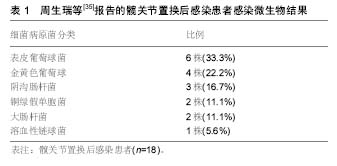
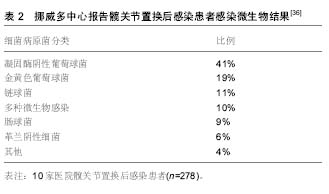
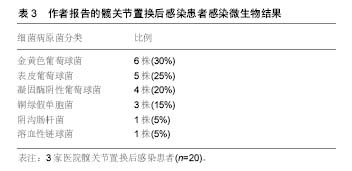
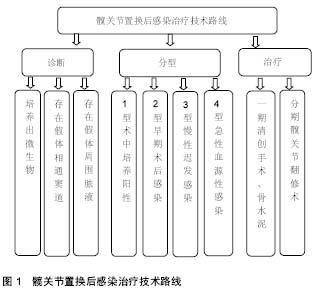
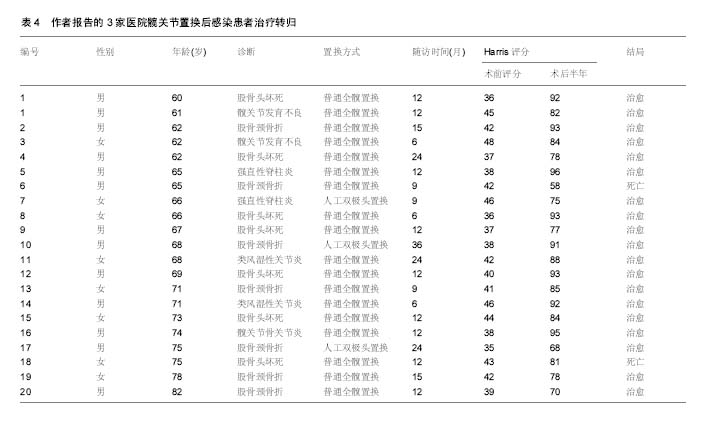
.jpg)